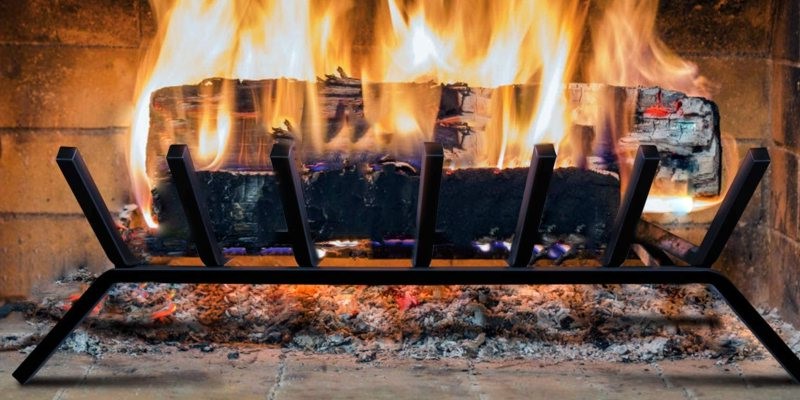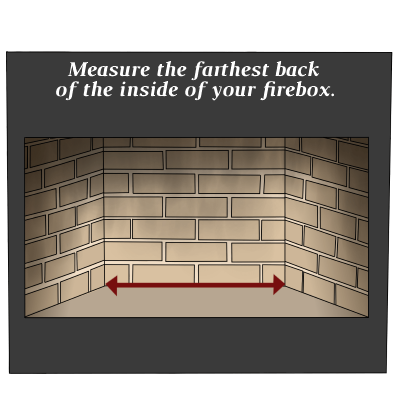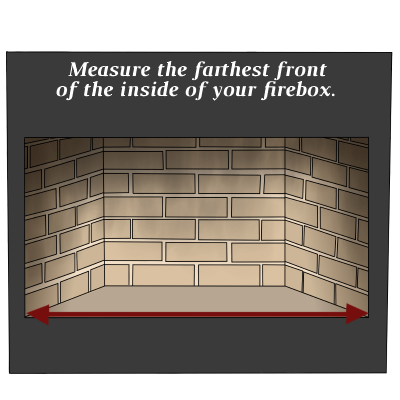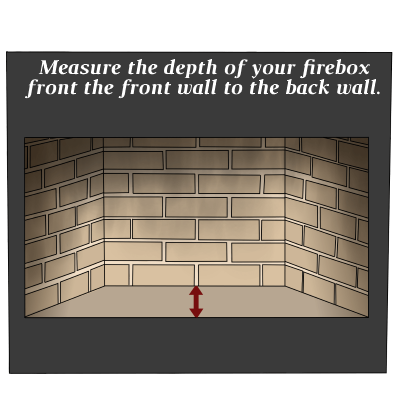Fireplace Grate Buyer's Guide:
Are you in search of the perfect fireplace grate or aiming to enhance your knowledge about them? Look no further; you've landed on the right page. With a plethora of fireplace grates available, each catering to unique needs, understanding the factors involved is crucial. This comprehensive guide will assist you in selecting the ideal fireplace grate for your hearth.
Understanding Fireplace Grates:
A fireplace grate is essentially a log holder positioned directly on the hearth floor, elevating logs to facilitate better oxygen flow to the fire. This simple yet effective addition not only enhances the longevity of your fireplace but also contributes to a higher quality burn, reducing maintenance efforts.
Why Invest in a Fireplace Grate?
Fireplace grates offer multifaceted benefits, significantly improving the functionality of your hearth:
- Efficient Fires: Grates elevate logs, promoting efficient combustion and producing aesthetically pleasing flames.
- Improved Oxygen Flow: Enhances oxygen circulation, making ignition and maintenance of the fire easier.
- Reduced Smoke: By keeping the fire off the floor, grates assist in directing smoke into the chimney instead of your living space.
- Extended Fireplace Lifespan: Prevents direct contact of logs with the hearth floor, contributing to the longevity of your fireplace.
- Easy Maintenance: Grates with gaps or holes facilitate the collection of ash in small sections, simplifying the cleaning process.
If You Already Have a Fireplace Grate:
Factory-provided grates are common, but they often lack advanced features. While they may have upturned grate fingers, they might not include rear fingers, leading to potential issues like logs rolling off and causing damage. If burning cordwood, an upgrade is advisable to ensure optimal performance.
- Before You Buy: Before making a purchase, consider the following:
- Size Matters: Measure the width and depth of your fireplace, subtracting six inches from each dimension to determine the right size. Read our next articel below about fireplace grate clearances.
Grate Types:
- Standard Steel Bar Stock Grate: Basic, cost-effective model with square steel bar fingers.
- Stainless Steel Bar Stock Grate: Similar to standard grates but crafted from weather-resistant stainless steel.
- Diamond Cross Section Steel Grate: Enhanced strength with a diamond cross-section and an ember mesh tray.
- Cast Iron Basket Grates: Designed for wood burning or coal appliances, featuring small openings for ember drop.
- Self-Feeding Grates: Concave design keeps logs centered for a compact and hot fire.
Leading Brands: Several reputable brands offer quality fireplace grates:
- Uniflame: Known for a wide range of sturdy and affordable fireplace grates.
- HearthCraft Essential: Producer of fireplace grates, doors, screens, and more, ensuring durability and quality.
- Vestal Manufacturing: With over 65 years in business, focuses on quality fireplace accessories made from cast iron and steel bar.
- Pilgrim: Crafters of one of the nation's best-selling fireplace grates, featuring heavy build and a lifetime warranty.
- Stoll Industries: Crafting an array of fireplace essentials including grates, doors, screens, and beyond, our producer prioritizes durability and quality in every product.
Caring for Your Fireplace Grate: Extend the life of your grate with proper care:
- Knock off larger ash chunks during cleaning.
- Use a wire brush for smaller ash clumps.
- Rinse with a damp rag, using only water to avoid hazardous residues.
- Allow it to dry thoroughly.
- Refer to the owner's manual and warranty information for specific care instructions.
Armed with the knowledge of finding the right grate size, understanding grate types, recognizing reliable brands, and knowing how to care for your grate, you're ready to explore our top selection of fireplace grates. Should you have any lingering questions, our specialists at Fireplace Doors Online are always available to assist you. Happy hearth crafting!
Clearances for Wood Fireplace Grates in the Firebox:
When placing a wood fireplace grate in the firebox, it's crucial to maintain clearances to ensure safe and efficient operation.
Recommended Clearances:
Back Wall Clearance: Leave at least 2 inches of clearance between the back of the fireplace grate and the back wall of the firebox. This prevents overheating and potential damage.
Side Wall Clearance: Maintain a minimum of 4 inches of clearance between the sides of the grate and the interior walls of the firebox. This prevents excessive heat transfer to the walls.
Front Clearance: Allow for a clearance of 4 to 6 inches between the front of the grate and the fireplace opening. Sufficient front clearance ensures proper air circulation.
Floor Clearance: Maintain a minimum clearance of 2 inches between the bottom of the grate and the fireplace floor. This allows for proper air circulation and helps protect the floor.
Clearances for Fireplace Glass Doors:
When using fireplace glass doors in conjunction with a wood fireplace grate, it's essential to adhere to recommended clearances.
Recommended Clearances:
Minimum Grate-to-Door Clearance: Ensure a minimum clearance of 4 inches between the top of the wood fireplace grate and the bottom edge of the fireplace glass doors. This prevents interference and overheating.
Door Frame to Firebox Opening Clearance: Leave a clearance of at least 1 inch between the frame of the glass doors and the sides and top of the firebox opening. This prevents direct contact and potential damage.
Floor Clearance for Glass Doors: Maintain a clearance of at least 1 inch between the bottom edge of the glass doors and the fireplace floor. This prevents overheating and potential damage.
Cleaning Your Wood Fireplace Grate:
Cleaning your wood fireplace grate is essential for maintaining its functionality and ensuring a safe and efficient wood-burning experience.
Steps to Clean Your Wood Fireplace Grate:
Allow the Grate to Cool: Ensure that the grate has cooled down completely before attempting to clean it. Attempting to clean a hot grate can be dangerous.
Remove Unburned Logs and Ash: Carefully remove any unburned logs and excess ash from the grate. Use a fireplace shovel or a small brush to collect the ash for easy disposal.
Scrubbing the Grate: For stubborn residue or buildup, use a wire brush to scrub the surface of the grate. This helps remove any caked-on debris that may hinder proper airflow.
Dispose of Ash: Dispose of the collected ash in a safe manner, following local guidelines. Ash can be used as a fertilizer or added to compost in moderation.
Inspect for Damage: Take the opportunity to inspect the grate for any signs of damage or wear. Cracks or weak spots should be addressed promptly to ensure safety.
Reassemble and Reinstall: Once cleaned and inspected, reassemble the grate and place it back in the fireplace. Ensure that it is positioned securely and ready for use.
 Fireplace log grates can provide you with a more efficient fire, and also helps increase airflow through your fireplace. There are a few different kinds of fireplace wood grates, it is important to use the right one for your fireplace. We will explain the details about each grate below.
Fireplace log grates can provide you with a more efficient fire, and also helps increase airflow through your fireplace. There are a few different kinds of fireplace wood grates, it is important to use the right one for your fireplace. We will explain the details about each grate below.
Our collection of wood-burning fireplace grates are made from heavy-duty metal stock to ensure a stronger, longer-lasting product! Keep your logs elevated above the floor in your firebox and promote better air circulation for a hotter, more efficient burn. Our cast iron and steel grates also allow coals to develop underneath as the wood burns, which further contributes to the warmth you'll experience! Choose from a number of sizes and styles to suit your needs. These affordable fireplace grates are a terrific addition to any wood burning masonry or zero-clearance unit!
Different Types of Fireplace Grates
- Cast Iron - Cast iron fireplace grates are great for burning coal or wood. Typically these grates have small gaps that allow smaller pieces of wood and coal to burn through before falling onto the firebox floor. This helps to increase the overall efficiency of the burn.
- Reduced Depth - Small depth grates are necessary for fireplaces that have smaller than average fireboxes. Just like with gas logs, you want to have some clearance between your fireplace grate and your firebox walls. Reduced depth grates can be made from cast iron or welded steel bars.
- Lifetime Grates - Lifetime fireplace grates are just like they sound, gauranteed by the manufacturer to last a lifetime. The lifetime fireplace grates we offer are constructed from carbon steel, with flat bars across the top of the grate. Typically the clearance of these grates is 3-4".
- Welded Steel - These are heavy duty fireplace grates, made from solid steel barstock. The barstock is either 1/2" or 5/8" thick, depending on the model. Most of the welded steel fireplace grates we offer are tapered and considered self feeding.
- Stainless Steel - Outdoor fireplace grates are made from stainless steel. Regular steel fireplace grates will rust and degrade over time if left in outdoor environments. Stainless steel is much better for outdoor environments and will hold up much longer than a standard fireplace grate.
- Fireplace Grate Heaters - Grate heaters are made from steel tubing and contain a blower fan. The wood is stacked on top of the grate, and the heat transfers into the hollow metal framework of the heater. The blower then circulates the hot air throughout the living space.
Wondering what size fireplace grate you'll need for your wood-burning fireplace? Just like gas logs, fireplace grates need to be the approriate size for your firebox. The guide below will show you how to measure your firebox and calculate what size fireplace grate you will need.
We're going to give you quick, easy to follow instructions for this process! Grab a pencil and paper as well as a metal tape measure. In the following demonstration, we're featuring a zero clearance fireplace for measuring purposes:

Step 1:
First, start by measuring the inside of your firebox at the farthest back width. Let's assume your measurement is 33 inches.
Step 2:
Next, measure the inside of your firebox at the farthest front width. Let's assume your measurement is 49 inches.
Step 3:
Finally, measure the depth of your firebox, from the back wall to the front of your firebox. We're going to assume the measurement is 20 inches.
For safety and proper functioning of your fireplace, we recommend a 3-inch clearance on all sides of the log grate to the three interior walls and opening of the firebox. Take the smallest width, which is 33 inches in the above example, and subtract 6 inches. This will give you a dimension of 27 inches for the width of your log grate. Now subtract 6 inches from the depth, which in this case was 20 inches. You would need a log grate that is 27 inches wide with a maximum 14-inch depth. In the above example, our F-Series Zero Clearance 27 Inch Fireplace Grate would be perfect!
Frequently Asked Questions:
Q: Do I need a wood fireplace grate for my fireplace?
A: Yes, a wood fireplace grate is highly recommended for optimal performance, efficiency, and safety.
Q: Can I use any type of wood with a fireplace grate?
A: Generally, any seasoned hardwood works well with a fireplace grate. Avoid using wet or unseasoned wood.
Q: How often should I clean my wood fireplace grate?
A: Cleaning frequency depends on usage, but a monthly cleaning is a good practice. Regular inspections are also recommended.
Q: Can I use a fireplace grate in a gas fireplace?
A: No, fireplace grates are designed specifically for wood-burning fireplaces and should not be used in gas fireplaces.
Q: Are there different sizes of fireplace grates?
A: Yes, fireplace grates come in various sizes to accommodate different fireplace dimensions. Measure your fireplace before purchasing.
Q: Can I leave the ash under the grate between uses?
A: It is advisable to remove ash regularly to prevent airflow obstruction. Leaving a small layer of ash may help with insulation.
Q: How do I know if my fireplace grate is damaged?
A: Inspect the grate for cracks, warping, or weakened areas. If you notice any damage, replace the grate promptly.
Q: Are there alternatives to metal fireplace grates?
A: While metal grates are the most common, there are also cast iron and stainless steel options, each with its unique benefits.
Q: Can I use a fireplace grate with artificial logs?
A: It is not recommended, as artificial logs are often designed for use without a grate to allow for proper combustion.
Q: How can I increase the lifespan of my fireplace grate?
A: Avoid burning excessive amounts of softwood, as this can contribute to faster wear. Regular cleaning and inspections also contribute to longevity.
A wood fireplace grate is an indispensable accessory that enhances the functionality and safety of your fireplace. By understanding its benefits, cleaning procedures, and addressing common questions, you can make the most of this simple yet essential fireplace accessory, ensuring cozy and efficient wood-burning experiences for years to come.
